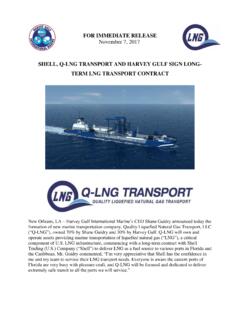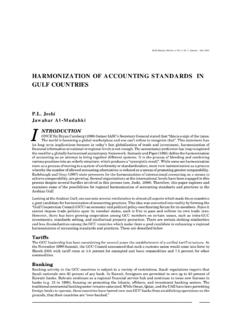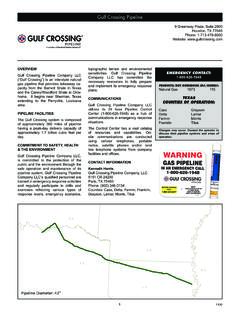Transcription of Shoreline reconstructions for the Persian Gulf since the ...
1 EPSL. ELSEVIER Ear&h and Planetary Science Letters 142 ( 1996) 43-57. Shoreline reconstructions for the Persian gulf since the last glacial maximum KurtLambeck *. Research School of Earth Sciences, The Australian National University. Canberra, ACT 0200, Australia Received 24 October 1995; accepted 2? March 1996. Abstract Sea-level change in the Persian gulf since the time of the last maximum glaciation at about 18 000 yr BP is predicted to exhibit considerable spatial variability, because of the response of the Earth to glacial unloading of the distant ice sheets and to the meltwater loading of the gulf itself and the adjacent ocean. Models for these glacio-hydro-isostatic effects have been compared with observations of sea-level change and palaeoshoreline reconstructions of the gulf have been made. From the peak of the glaciation until about 14000 yr BP the gulf is free of marine influence out to the edge of the Biaban Shelf.
2 By 14000 yr BP the Strait of Hormuz had opened up as a narrow waterway and by about 12500 years ago the marine incursion into the Central Basin had started. The Western Basin flooded about 1000 years later. Momentary stillstands may have occurred during the gulf flooding phase at about 11300 and 10500 yr BP. The present shorelines was reached shortly before 6000 yr ago and exceeded as relative sea level rose l-2 m above its present level, inundating the low-lying areas of lower Mesopotamia. These reconstructions have implications for models of the evolution of the Euphrates-Tigris-Kan delta, as well as for the movements of people and the timing of the earliest settlements in lower Mesopotamia. For example, the early gulf floor would have provided a natural route for people moving westwards from regions to the east of Iran from the late Palaeolithic to early Neolithic. Keywords: Persian gulf ; paleogeography; coastlines; last glacial maximum; upper Paleolithic; Neolithic 1.
3 Introduction where subsidence is postulated to have been signifi- cant in recent geological time. Today, the Tigris and The Persian gulf is a long and shallow, almost Euphrates rivers flow along the length of the topo- enclosed sea bounded at the south and west by the graphic low of the Mesopotamian lowlands and, with Arabian platform and to the north and east hv -, the ---- the Karun River, they combine to form the extensive tectonically active Zagros Mountains (Fig. 1). The Shatt-al-Arab estuary, marsh area and deltaic system latter, defining the zone of convergence between the at the head of the gulf . Water depths in the gulf do Arabian and Eurasian plates, represent a zone of not generally exceed 100 m and the average depth is active tectonics and uplift, whereas the gulf , and its only about 35 m. Thus, as has been widely recog- northwesterly extension into Mesopotamia, is a zone nised, much, if not all, of the gulf has been above sea level during glacial time 111.
4 The timing and * Fax: + 61 6 249 5443. E-mail: progress of the flooding of the gulf since the last 0032-821X/96/$ Copyright 0 1996 Published by Elsevier Science All rights reserved. f/I SOOl2-821X(96)00069-6. 44 K. Lambeck / Earth and Planetary Science Letters I42 (19%) 43-57. Holocene. Furthermore, the models provide the ref- erence with respect to which rates of vertical tecton- ics can be evaluated for areas where such move- ments are of a magnitude that is comparable to the rates of sea-level change. At the same time, observa- tions of the sedimentary record, or of the sea-level change, provide further constraints on both the eu- static sea-level function and the glacio-hydro-iso- static models. Finally, they permit reconstructions to 26. be made of the shorelines of the region, which are of interest for assessing possible human settlement loca- tions and migration routes from the Palaeolithic to Neolithic.
5 22. 44 m 56. Fig. 1. Setting of the Persian gulf . The areas of darker shading 2. The glacio-hydro-isostatie model define the relief above 1000 m. The depth contours in the Persian and Oman Gulfs are at 50 and 100 m. Locations of some sites The elements of the glacio-hydro-isostatic model mentioned in text are numbered l-12. I = Umm Al Qayayn;. have been discussed elsewhere and have been tested 2 = Salwah; .?=Qurayyah; 4= Dhahran; 5= Al Jabayl; 6=. Lawdham; 7 = Al Wusail and Khor; 8 = Bir Zekrit; 9 = Khor against observational data in numerous localities. An Milh; 10 = Abu Abah; II= Shinas; 12 = Rud-e Chaharu. The essential aspect of the model is that the sea-level locations 45, 46, 57, 58 refer to four Atlantis II core sites. Other change produced by the melting of the ice sheets of place locations for lower Mesopotamia are given in Fig. 8. Late Pleistocene time is not spatially uniform and that, in general, it will differ substantially from the eustatic sea-level curve.
6 Schematically, this vatiabil- glacial maximum has, however, been poorly con- ity, Ac((p,t) of past sea levels at time t and position strained; in part because the knowledge of the eu- cp expressed relative to present sea level, can be static sea-level change remains imperfect, in part written as [2,3]: because the isostatic consequences of glacial loading and unloading have not previously been considered, and in part because the tectonic uplift or subsidence over the period are not readily evaluated indepen- dently of the sea-level fluctuation. The sequence of (la). flooding and desiccation events before the last glacial = K(r) + A{,;( cp~) + A&( cp~) (lb). maximum are even less well constrained for exactly the same reasons. The first term on the right-hand side of Eq. (la) is The glacio-hydro-isostatic models, particularly the eustatic sea-level change, defined as: for regions away from the former areas of glaciation, change in ocean volume are now sufficiently well constrained and of ade- K',(r) = (14.))}
7 Area of ocean surface quate spatial resolution to enable realistic models of the palaeo- shorelines and water depths to be con- and the last term is the change from other tectonic structed since the time the ice sheets were last at processes. The three terms making up A{,((p,t) de- their maximum volume. Such models would con- fined by Eq. (lb) are the glacio-hydro-isostatic tribute to the understanding of the sedimentology of departures of sea level from the eustatic approxima- the gulf floor and may provide constraints on models tion. The first of these, At,, is the change produced of the movement of the northern Shoreline at the by the gravitational attraction between the ice sheets, head of the gulf through progradation of the Tigris- the ocean waters and the land, evaluated in the first Euphrates Delta in the latest Pleistocene and instance as if the Earth were rigid. It is a function of K.)}
8 Lambeck/ Earth and Planetary Science Letters 142 119%) 43-57 45. both time and position and its influence extends ocean basins into which the meltwater is added. This beyond the limits of the ice sheet. The second term, last will itself be a function of time and of the Ali, describes the glacio-isostatic effect, the change sea-level change and the A(, term is evaluated in an in sea level produced by the response of the crust, iterative manner. The actual formulation and solution elastic and viscous, to the unloading (or loading) of of Eq. (la) is complex because, as noted above, the the ice. It includes both the radial deflection of the sea-level change A(((p,t) enters into the hydro-iso- crust and the gravitational effect of the redistribution static term A{,,, on the right-hand side as well. of mass within the Earth. This term can also be Details of the formulation are discussed in [3-51.))]}
9 Significant out to large distances beyond the former In tectonically quiet areas observations of sea-level areas of glaciation. It is a function of position and change permit the eustatic sea-level function and the time and its evaluation requires a knowledge of the earth and ice model parameters defining A<, to be changing ice sheets and of the rheological response evaluated ( [6]). In tectonically active areas At, of the planet. The third term, A[ w, making up A<,, and A(r may be of comparable magnitude, as in the describes the hydro-isostatic effect of the loading of Aegean area, and the neglect of At, can lead to the crust by the meltwater added into the oceans (or misleading estimates for rates of tectonic movement extracted from it> as the ice sheets decay (or grow). [71. In this case, it may be better to assume that A<, This term is a function of the Earth's rheology, the and AC1 are known, based on analyses from stable timing of the addition of the meltwater, of the amount regions, and to evaluate the corrected' relative sea- of meltwater added, and of the geometry of the level data in terms of tectonic processes.))]]
10 ICC load componcnr 32 . a Rigid compncn~ ICC load component b 4x0 56 . Fig. 2. Rigid A[, (left-hand side) and glacio-isostatic A<' (right-hand side) contributions to sea-level change (in metres) from the Arctic ice sheets at (a> 18 000 yr BP and (b) 10 000 yr BP for the ice sheets. 46 K. Lambeck/ Earth and Planetary Science Letters 142 (19%) 43-57. The evaluation of the isostatic terms requires, in [l 11. Fig. 2 illustrates the components for the Arctic addition to the physical and mathematical framework ice sheet model whose eustatic contribution at the and the eustatic sea-level function, a knowledge of time of the last glacial maximum is 90 m. The the Earth's rheology and of the ice-sheet configura- Antarctic eustatic contribution is about 37 m, making tions through time. Figs. 2 and 3 illustrate the three up a total eustatic change of 127 m since the last isostatic contributions for the Persian gulf region glacial maximum.)]]





